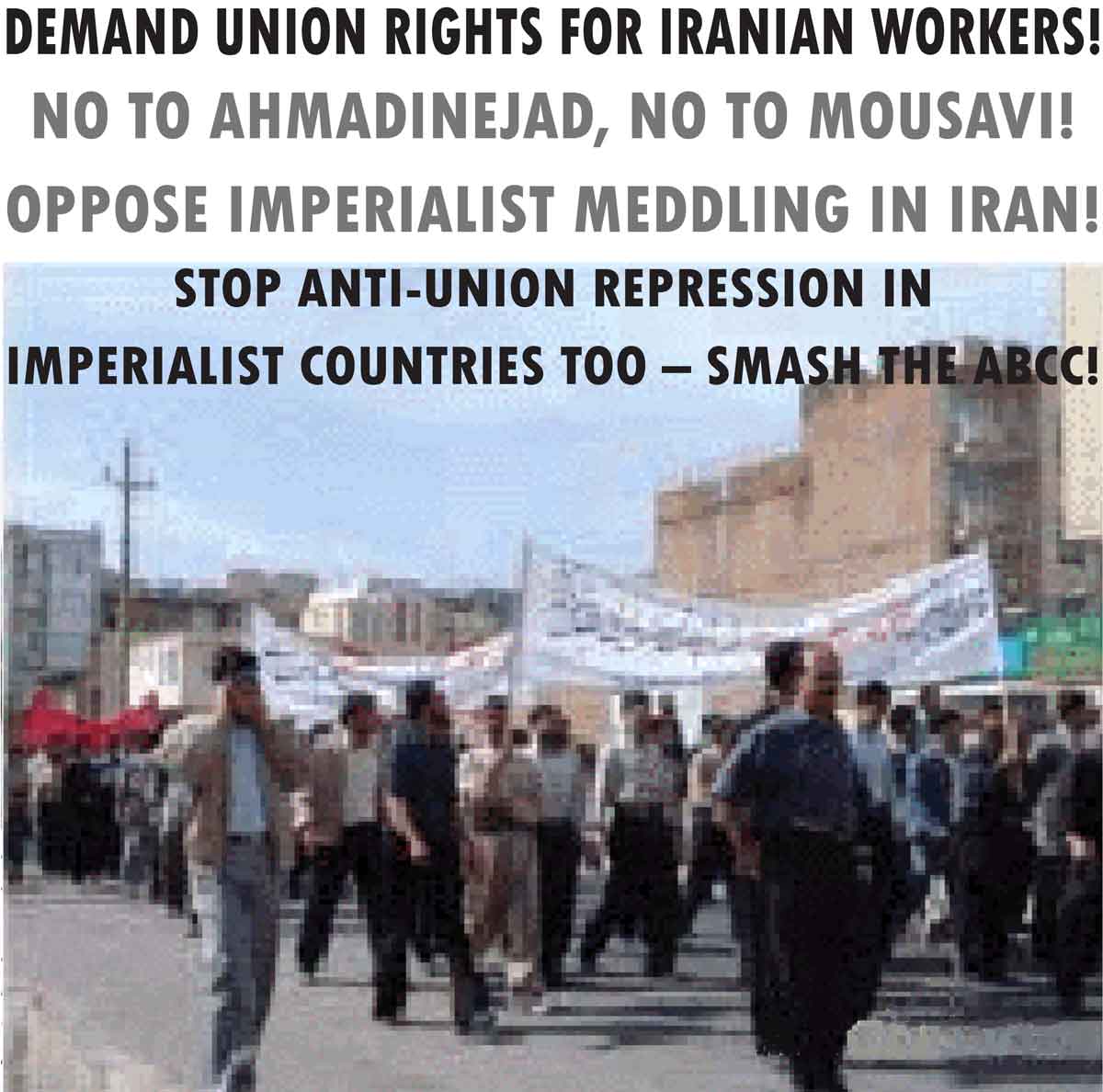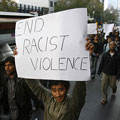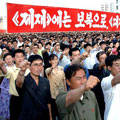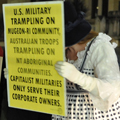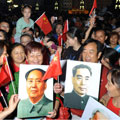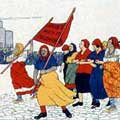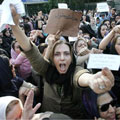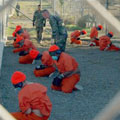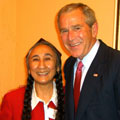Iran, May 2008:Thousands of striking Haft Tapeh sugar cane workers march through the town of Shush demanding payment of unpaid wages and the release of jailed strike leaders. Working class mobilised independently of all wings of the capitalist class is the force that can lead struggle for social liberation in Iran.
June 25 - Trotskyist Platform passes on our greetings to fellow supporters of the struggle for trade union rights in Iran. We join in with workers organizations like the International Transport Workers Federation and the Maritime Union of Australia and with other leftist groups in Iran and Australia in calling for the immediate release of jailed Iranian trade unionists Mansour Osanloo, Ebrahim Madadi, Farzad Kamangar and the five leaders of the Haft Tapeh Sugarworkers Union.
The Iranian capitalist ruling class - including all its competing factions – is a vicious enemy of the working class. On May Day, Iranian police and paramilitary forces brutally attacked a thousands strong workers’ demonstration and arrested over 170 participants. Some have been released but many are still detained. We add our voice to calls for the immediate release and dropping of all charges against these May Day demonstrators.
It is hardly just in Iran that workers organizations are under attack. While the Western tycoon-owned media would like to focus only on the crimes of regimes like Iran that are currently being disobedient to the imperialists, repression against trade unionists is also very severe in U.S.-backed “democracies.” In capitalist South Korea (which is occupied by tens of thousands of U.S. troops that target socialistic North Korea), over 450 trade unionists were arrested following a May 16 workers rally in the city of Daejon (The Straits Times [Singapore], May 18.) Workers at the rally were carrying slogans in honour of union leader Park Jong-Tae who had been hounded into suicide by the state – Park was being hunted down to be jailed for “organizing illegal protests.” But when the workers tried to march on May 16, they were blocked by the South Korean police. In the resulting confrontation, police brutally smashed demonstrators with batons. Over 100 protesters were injured. Police then indiscriminately arrested anyone wearing a union vest on nearby sidewalks and in restaurants after the rally had dispersed. Severely injured arrestees had to sign confessions at the police station before getting any medical treatment.
Meanwhile, in the Philippines, the Washington and Canberra-backed “democratic” government of Gloria Arroyo has overseen a brutal terror campaign against trade union members and leftists by the military and right wing death squads. Hundreds of trade unionists and leftists have been murdered in the Philippines in the last few years alone.
Even in the richer imperialist countries, repression against workers is intensifying. As the corporate owners try to make workers pay for the crisis of their own capitalist system, they are doing everything they can to stop any union fightback. Here, Rudd and Gillard’s ALP regime has maintained most of Howard’s anti-strike laws in their Workchoices Lite industrial relations package. They are also committed to continuing under a new name that Gestapo-like agency targeting building workers: the ABCC. Currently, South Australia CFMEU union member, Ark Tribe, is facing jail just for refusing to dob in his union comrades to the much hated ABCC.
No to All Wings of The Iranian Ruling Class!
Yes to The Struggle for Workers and Women’s Rights!
The June 26 International Day of Action to support Iranian workers arrested on May Day comes at a crucial time, a time of severe crisis in Iranian society. But no side in the current power struggle, images of which we are consistently bombarded with by the Western media today, represents the interests of the working class and oppressed. On the one side are the current administrators of Iranian capitalism – President Ahmadinejad, the supreme leader of the Islamic Republic Ali Khamenei and their “Revolutionary Guards” and associated paramilitaries. This so-called conservative faction upholds all the current oppressive laws restricting the freedom of women. They have conducted privatizations of state owned enterprises and their policies have brought inflation and unemployment. Under their administration, the Iranian state has continued to whip and torture worker activists and today they are administering murderous repression against the protests supporting their rivals.
On the other side are people led by Ahmadinejad’s electoral rival Mir-Hossein Mousavi. Mousavi himself is part of the Iranian ruling elite. The only four candidates allowed to stand for presidential election, including Mousavi, were selected by the clerical Council of Guardians for their commitment to the core aspects of the religious fundamentalist regime. For most of the 1980s, Mousavi was prime minister and oversaw murderous terror against leftists, women, Kurds and other ethnic minorities. While today he opposes the hated “Morality Police” and some of the worst aspects of women’s oppression, Mousavi continues to uphold all the fundamental restrictive laws against women. Even at rallies in his support he has berated some women participants for wearing a “bad hijab (headscarf)” – i.e. for showing too much of their face and head. Meanwhile, Mousavi is a more extreme supporter of “neoliberal” economic policies than Ahmadinejad. He has criticized Ahmadinejad for not being fast enough in implementing privatizations and has attacked the president’s welfare programs.
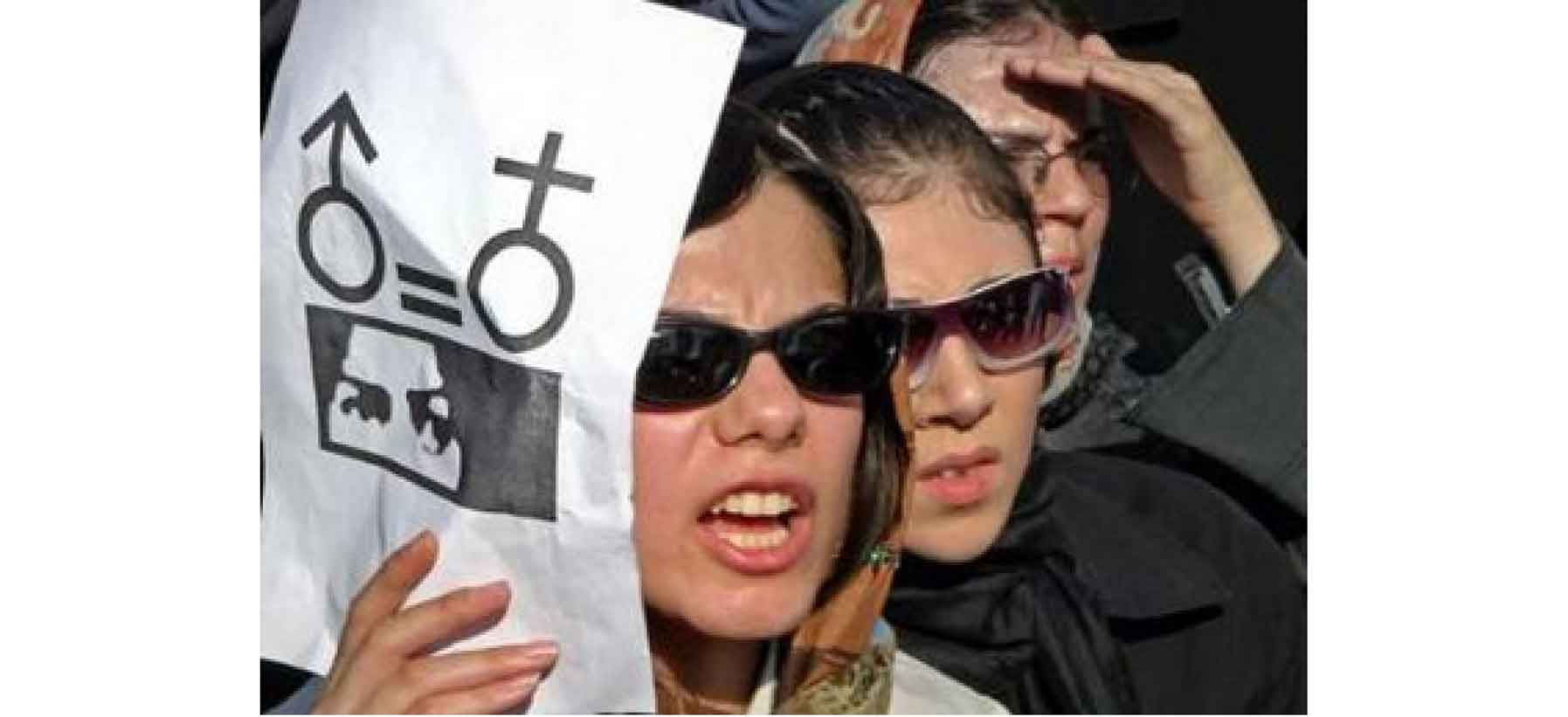
Demonstrators at the June, 2005 protest at Tehran University to demand an end to discrimination against women.
The current upheaval in Iran began after Mousavi and his supporters staged mass protests against Ahmadinejad’s resounding victory in the recent presidential election, claiming that the result was caused by fraudulent vote tallying (there is doubt as to whether these claims are valid.) However, the protests have drawn into them a wide range of people who have a beef against the current administration: from, on the one hand, opponents of anti-women and other social restrictions to urban, upper-middle class elements who want to cosy up to Western imperialism and who consider that Ahmadinejad is favouring the rural poor at their expense.
Mousavi and his clique have done their best to contain the mass protests within the bounds of adherence to the theocratic order. His supporters have been organized to wear the colour green, the colour of the state religion (Islam) and the main chant of opposition rallies has been “Allah Akbar!” (“God is great!”) Yet, there have also been genuinely progressive elements – including women’s rights supporters and trade unionists – who have joined the protests seeking a chance to oppose the current regime. For this reason, some Marxist groups in Iran are supporting the opposition movement while being critical of Mousavi. They argue for a united front against the regime. A similar stance has been taken by some Western socialist groups – for example, by Socialist Alternative and the Solidarity groups – who appear to have been partly swayed by the propaganda of the Western bourgeois media in support of the opposition campaign.
However, while it is tempting to believe that a coalition of all opponents of the current Tehran administration regime can win some progressive change, the hard truth is that such cross-class, “pro-democracy” opposition movements inevitably get subordinated to the agenda and wishes of the capitalist components of the movement. This is in part because these bourgeois components have all the advantages that come from their wealth and position that enable them to control the movement: money to finance leaflets and hire meeting places, the backing of imperialist media and governments, a lighter treatment from the security forces than that faced by radical, pro-working elements etc. Moreover, all-encompassing movements, in order to hold themselves together, are always based on the lowest common denominator program, i.e. are based on an agenda that panders to the most conservative components of the coalition. The fact that this particular movement has arisen to support a strongly pro-privatisation, ruling class figure and the fact that it is being promoted by the Western imperialists makes it triply incapable of satisfying the aspirations of the Iranian masses.
What the Iranian trade union and left movement needs is not a united front with a wing of the capitalist elite but united front actions of themselves based on a program that is at once pro-working class, pro-women’s rights and anti-imperialist. The workers’ united front should organize anti-regime protests that are physically and politically separate from the pro-Mousavi demonstrations. Among the type of demands that such actions could call for include the following:
- Release all imprisoned trade unionists and pro-working class activists! Abolish all restrictions on trade unions!
- For the right of women to wear any style of dress they wish. For full equality before the law between women and men.
- For a big increase in the minimum wage and automatic wage rises for all workers as the cost of living increases.
- Halt all privatizations! For a massive increase in transfer payments to the poor from oil revenues (and not a reduction as Mousavi wants.)
- For the ending of all restrictions on the holding of rallies.
- Against all imperialist intervention in Iran.
- U.S and its allies get out of Iraq and Afghanistan now! Stop all Iranian backing for Iraqi groups that cooperate with the colonial occupiers!
By providing a truly progressive and pro-working class position, such a united-front movement would attract the worker and plebeian masses that are currently lined up behind one or the other of the competing ruling class camps. Genuine supporters of women’s rights and social freedom, for example, would be won over from the pro-Mousavi movement whose tepid program to relax anti-women restrictions is heavily limited by its links to the male chauvinist clergy and by its commitment to the anti-women theocratic system . On the other hand, by raising demands in the genuine interests of the toiling classes, the workers’ and lefts’ united front would attract the many poor people who are currently supporting Ahmadinejad not because they particularly adore him but because they rightly fear the “free market” policies of his rivals.
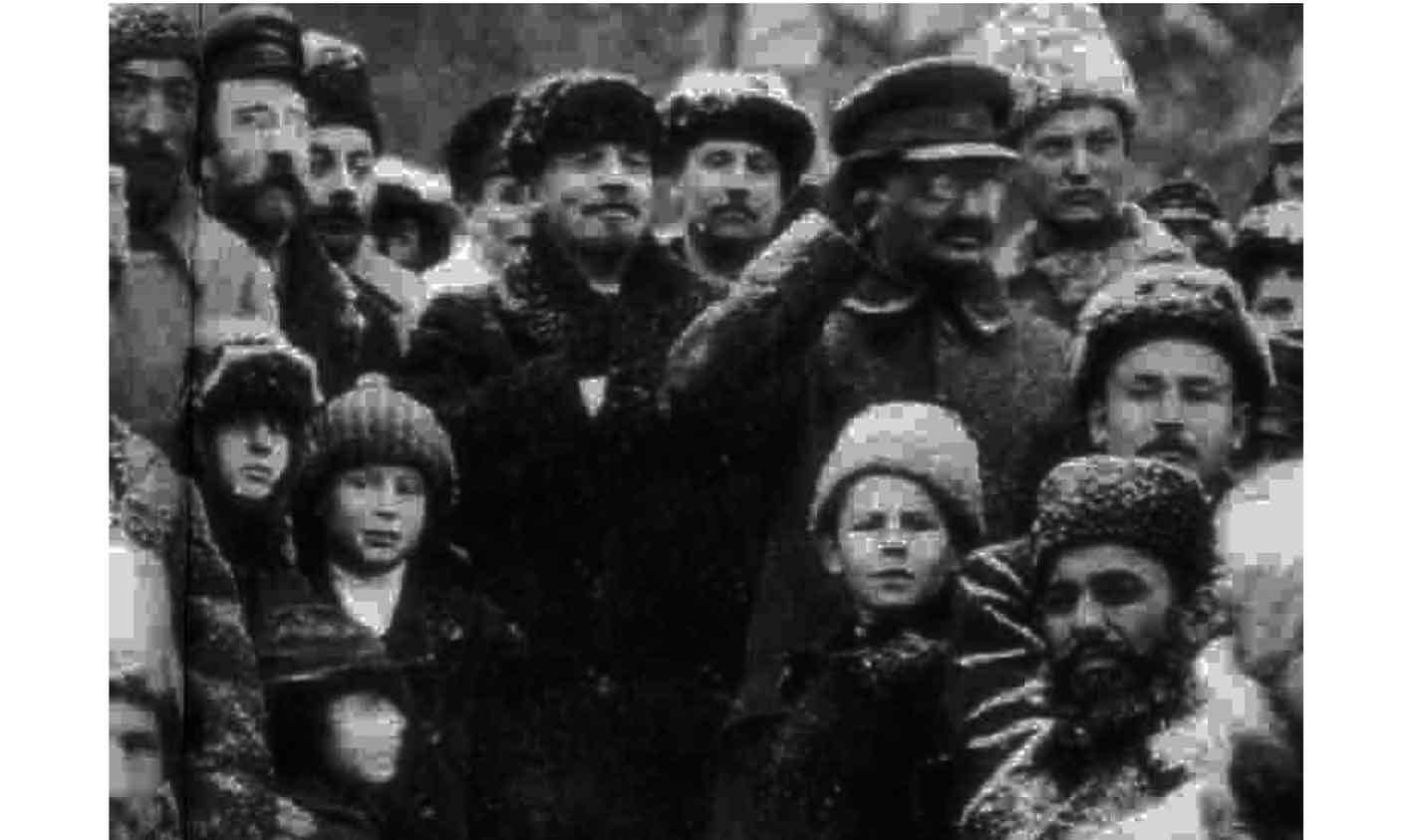
Leon Trotsky next to Lenin. Trotsky’s perspective of Permanent Revolution outlined that in countries of belated capitalist development, like Iran, even basic democratic tasks (like achieving legal equality for women and trade union rights) could only be achieved by the working class taking state power. The Russian Revolution led by Lenin’s Bolsheviks confirmed this perspective.
Those attracted to Ahmadinejad’s anti-imperialist rhetoric need to be won over too. After having suffered for a long time from the robbery and machinations of British and U.S. imperialism, the Iranian masses rightly hate the imperialist powers. They need to be convinced that only a pro-working class movement can be consistently and durably anti-imperialist. Even though some capitalist politicians in the poorer countries can for a while talk tough against imperialism, their dependence on the world market controlled by the capitalists of the richer countries drives them to eventually submit. Just look at Gaddafi ! He once talked like Ahmadinejad and now he is Washington’s boy. Even today the current Tehran regime, while backing forces in Palestine and Lebanon that are opposed to the U.S’s Israeli allies, directs its Iraqi proxies to cooperate (albeit uneasily and flippantly) with the U.S. colonial occupiers. Ahmadinejad’s Iraq policies are motivated not by principles of anti-imperialism but by the “regional power” ambitions of the Iranian capitalist class.
Within the pro-working class, pro-women’s rights and anti-imperialist united front that is so urgently needed in Iran, communists would advocate demands that go deeper than the united front’s program. They would raise demands such as for the shortening of the working week with no loss in pay to reduce unemployment, for the renationalization of privatized industries, for the ending of all religious instruction at school, for the complete separation of religion from state, for full rights for gays and lesbians and for the right to self determination of the Kurdish and other national minorities. The struggle to fulfill this program would pose the need to build towards the revolutionary seizure of state power by the working class and its allies.
The Western & Iranian Left Must Not Repeat The Mistakes of The Past
The June 26 Day of Action is an opportunity for the international workers movement to support an independent pro-working class intervention into Iran’s crisis. Based on the rallies’ principal slogans like “Demand union rights for Iranian workers” and “Free all jailed workers” Trotskyist Platform endorsed the June 26 action. At the same time in a communication formally sending through our endorsement (which was sent before the post-election upheaval began) we expressed some concerns:
“… As you know, for their own predatory reasons the U.S. imperialists and their allies like Australia and Israel have been targeting Iran. They seek to use legitimate criticism of the reactionary Tehran rulers to further their goals. That is why this rally must make absolutely clear that all imperialist intervention in Iran should be opposed.
“It must also be made clear that if there is a war between the Western powers and Iran, supporters of Iranian workers rights would militarily defend Iran against the imperialists while, of course, giving no political support to the fundamentalist regime.
“Imperialist intervention in Iran should be opposed even if it is made under the guise of protecting labour and human rights. Imperialist intervention tends to drive the Iranian toilers, who have a legitimate hatred of colonialism, back into the arms of its own bloody rulers. The job of defending Iranian worker rights is that of the Iranian working class and of the international working class.
“Based on the principle of opposing imperialist intervention, we oppose calls to “Put the Iranian regime on trial.” For to most people this means putting the regime on trial in the International Criminal Court or similar body. But currently the U.N. and other international bodies are under the control of the imperialist powers. So it would be the imperialists putting `the regime on trial.’ Any imperialist-inspired regime change in Iran would only mean the even more severe exploitation of Iranian workers as the imperialists would then demand a greater cut from the profits sweated out from Iranian workers’ toil….”
Today, given the widespread support (albeit with criticisms) given to the pro-Mousavi movement by much of the left, we are worried that our fellow endorsers of the June 26 rally will attempt to turn it into a demonstration supporting the current “mass movement” against the Iranian regime. We must, therefore, state that this is not what we endorsed and more importantly must warn fellow supporters of workers’ rights in Iran that such a change in thrust of the June 26 rally will do no good for the Iranian masses. We say this not out of some sort of “sectarian purity” but because it is our duty to express to others in the left what we know to be the case: that a mass movement that, regardless of the aspirations of some of its participants, is subordinated to a wing of the exploiting class will not be a movement for real social progress. Those on the left inclined to support the current protest movement in Iran should ponder the significance of Western imperialism’s promotion of this movement. The imperialists are the biggest exploiters of workers and are from Iraq to Afghanistan and from Guantanamo Bay to Bagram Air Base the most barbaric oppressive force in the world. They are not inclined to support progressive movements. A victory for the pro-Mousavi movement would likely see Iran ruled by a government that resembles some cross between on the one hand the ultra-conservative U.S.-backed regimes in Saudi Arabia and Kuwait and, on the other, the corrupt, pro-U.S. torturers that run Egypt.
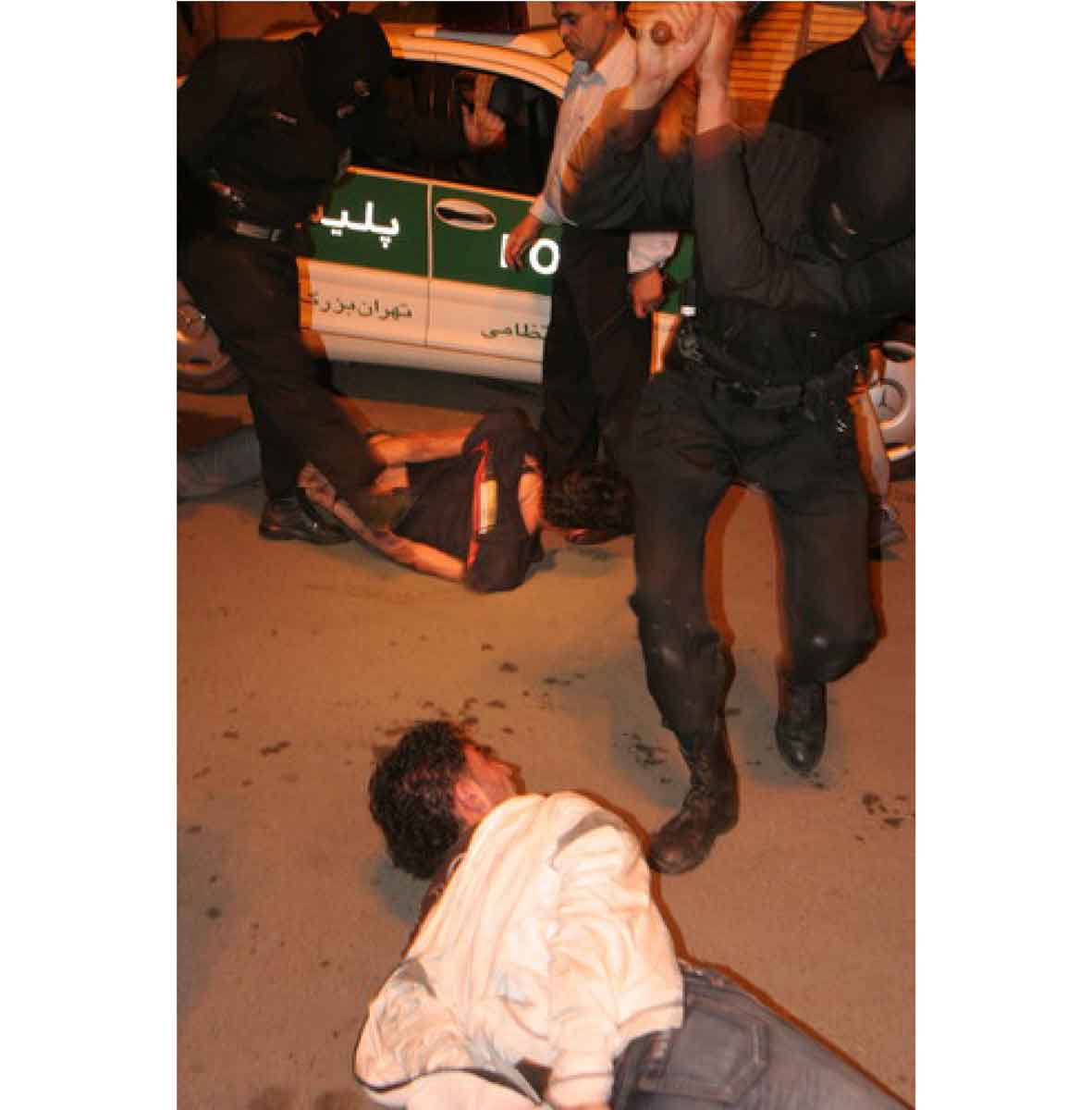
Brutal state repression in Ahmadinejad’s Iran. Such terror occurred also when today’s opposition leader Mousavi was Prime Minister in the 1980s. A pro-Western government would be just as, if not more vicious – recall the murderous SAVAK secret police of the Shah’s regime.
Some on the left, however, feel that if the left and workers movement plays as big a role as possible in the current anti-Ahmadinejad movement then they will have more weight to shape Iranian society should that movement triumph. History, however, has proven that when the working class joins with a capitalist-led mass movement, the victory of that movement will bring forth “new” capitalist rulers who are confident and arrogant because they feel that they have sufficient authority amongst the masses. That, in turn, just makes them feel that they can get away with cracking down on the most militant pro-working class elements. The recent history of the Philippines highlights this truth. In January 2001, massive protests called EDSA 2 erupted against the corrupt and repressive then Philippines president Joseph Estrada. The large Philippines left played a significant role in the movement but the movement was tied to the aspirations of one lot of the Philippines capitalist elite. When this new faction led by Gloria Arroyo took charge, it did not wait long before attacking the leftist participants in EDSA 2 with a murderous ferocity worse than in Estrada’s time. Moreover, 15 years prior to EDSA 2 was the original EDSA revolution. That mass movement, backed by major high-level military defections, brought down the decrepit regime of Ferdinand Marcos. The “pro-democracy” movement brought to power Marcos’s election rival Corazon Aquino. The new capitalist regime did not take long before intensifying repression against trade unionists, communists and poor peasants. On January 22, 1987, less than a year after taking power, the “democratic” Aquino government’s riot police opened fire on a mass demonstration of poor peasants calling for land redistribution and shot dead thirteen protesters.
Well-read leftists are familiar with these examples but nevertheless hope that a broad anti-regime movement in Iran will usher in a new bourgeois regime that will at least allow the masses more democratic space in which to organize progressive struggles. However, as Lenin’s Bolsheviks understood, no wing of the bourgeoisie, even the most liberal, can bring any kind of democracy to a backward country. This understanding was systematized in the Trotskyist perspective of permanent revolution. According to this theory, in the backward countries and those countries ground down by neocolonialism even basic democratic reforms - reforms which nations first on to the scene of capitalism had achieved a long time ago within the system of capitalist rule - could no longer be achieved under capitalist rule in this imperialist-dominated modern era. For the emergence of powerful and organized working classes toiling together in big workplaces has made the exploiting classes in these developing countries so scared that they are not willing to give up any repressive tool nor are they willing to dispense with ancient forms of social control – like institutionalized religion. In these countries, even the most basic democratic aims can only be achieved by the working class in power. This perspective was confirmed by the 1917 October Revolution in Russia. It took the workers taking power in October 1917 to finally bring to backward Russia an end to all feudal titles, separation of religion and state, equality before the law for men and women, the unrestricted right to marry and divorce, democratic rights for homosexuals and land to the tiller.
These lessons must be urgently studied by socialists. Or else, today, the international and Iranian left risks repeating the costly mistake it made in the late 1970s. It was then that the Iranian left which had led powerful workers’ struggles against the hated U.S.-backed Shah subordinated the working class to an all encompassing anti-Shah mass movement led by Khomeini’s religious fundamentalist forces. The left thought that nothing could be worse than the Shah. They hoped that his overthrow would at least ease the totalitarian terror. Instead, the new capitalist regime turned on its former left backers and executed thousands of members of the Iranian Tudeh, Fedayeen and other pro-socialist groups. It is a bitter irony that the mistake that the left may be headed towards today is a kind of reverse of what they did in the late 1970s. Then they made a united front with theocratic bourgeois forces against a mildly modernizing, U.S.-backed “free market” figure. Today, the left are starting to line up with a mildly modernizing, U.S.-promoted, “free market” figure against the theocratic bourgeois order.
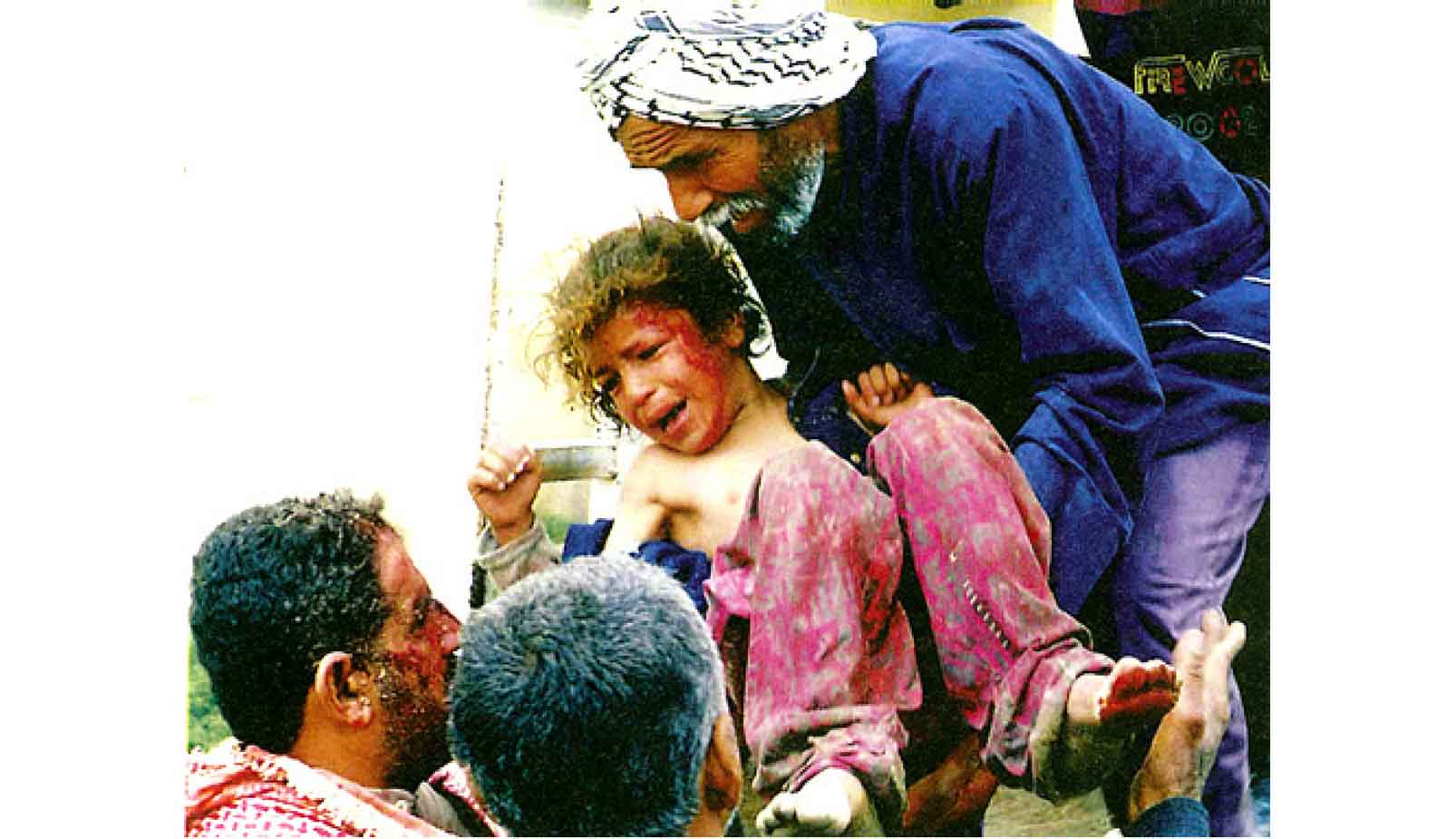
Iraq, 22 March 2003: An Iraqi man holds a child wounded in the attack by the U.S.-British Coalition on Basra. Imperialist
invaders killed tens of thousands of Iraqi civilians under the guise of “nuclear disarmament.” Today, international left must stand with Iran against any threatened imperialist attack.
But there is still time to change course! And the course must, indeed, be changed! For there is a window of opportunity for a pro-working class intervention in Iran independent of all wings of the ruling elite. It is time to take advantage of the deep split in the capitalist enemy class! To harness in the right direction the yearnings for freedom and women’s emancipation shown by many young Iranians. To build upon the confidence shown by the workers who defiantly gathered in Tehran to mark May Day. To stand upon the proud traditions of courageous resistance and pro-communist sympathy amongst the Iranian working class. Let us aid the Iranian masses by here in Australia building actions that stand against both the woman-hating Ahmadinejad clique and the “free market” Mousavi/Rafsanjani lot on a program that is at once pro-trade union, pro-women’s rights and anti-imperialist.
However, let us not forget that the best way we can encourage the working class movement in Iran is by fighting against our own capitalist exploiters here in Australia. Let us dispel through our struggles the Western media propaganda into Iran that everyone in the West loves the “democratic” neoliberal order. Let us prove to the Iranian masses that the choice is not between an anti-Western theocratic dictatorship and a more pro-imperialist neoliberalism but between all manner of capitalist rule and the struggle for justice of the working class. Let us here take industrial action to smash the ABCC and its sequel, to defeat all the Workchoices Lite anti-strike laws and to stop multimillionaire corporate owners from slashing jobs. Down with anti-working class attacks from Sydney to Seoul to Tehran and Paris! Down with Rudd and Turnbull, Down with Ahmadinejad and Mousavi! Up with the struggle for working class and women’s emancipation!
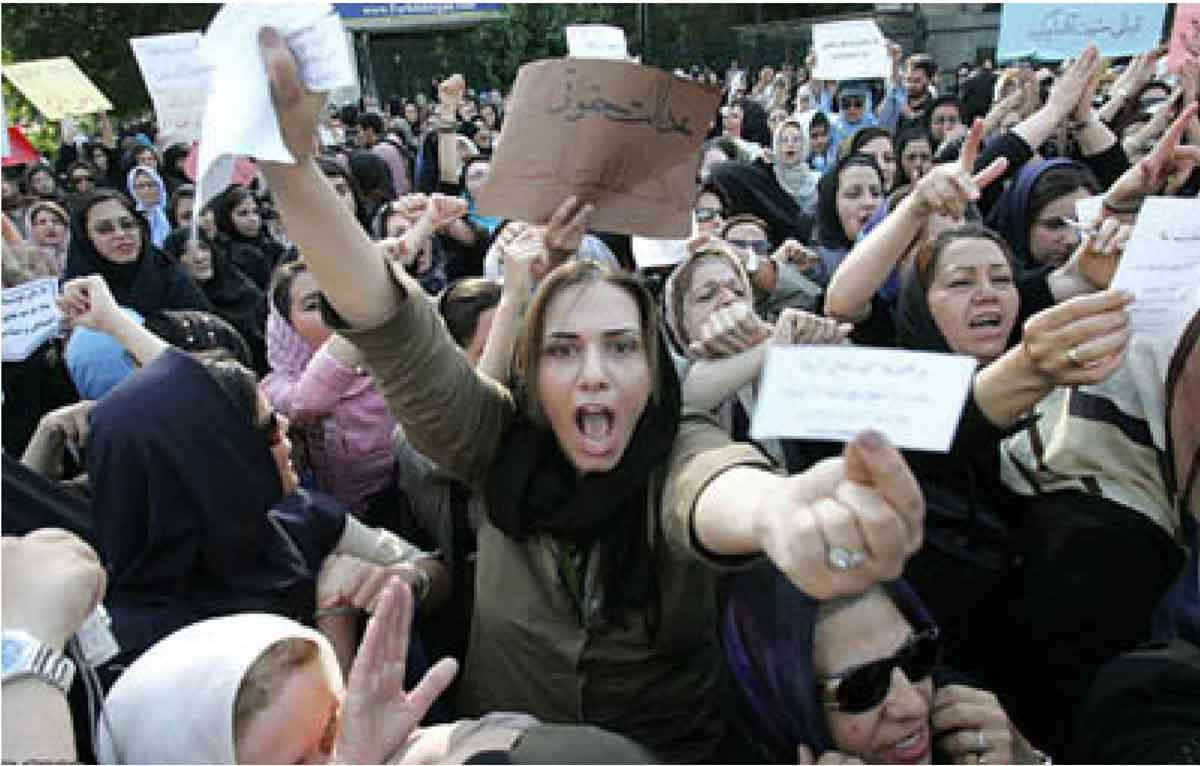
June, 2005: Hundreds of people protest at Tehran University to demand an end to discrimination against women. Struggle for women’s equality must be a key part of any socialist liberation movement in Iran.
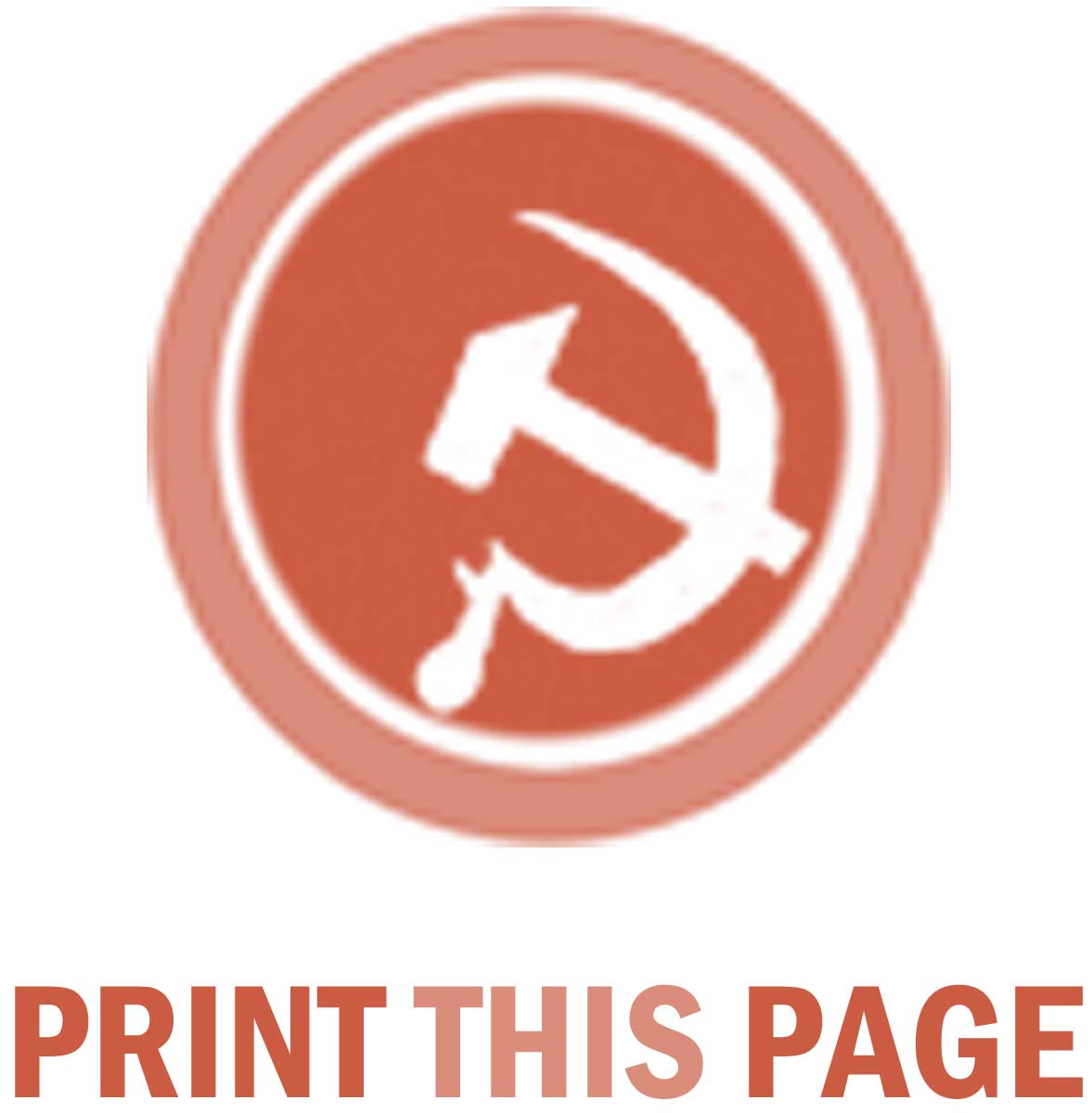
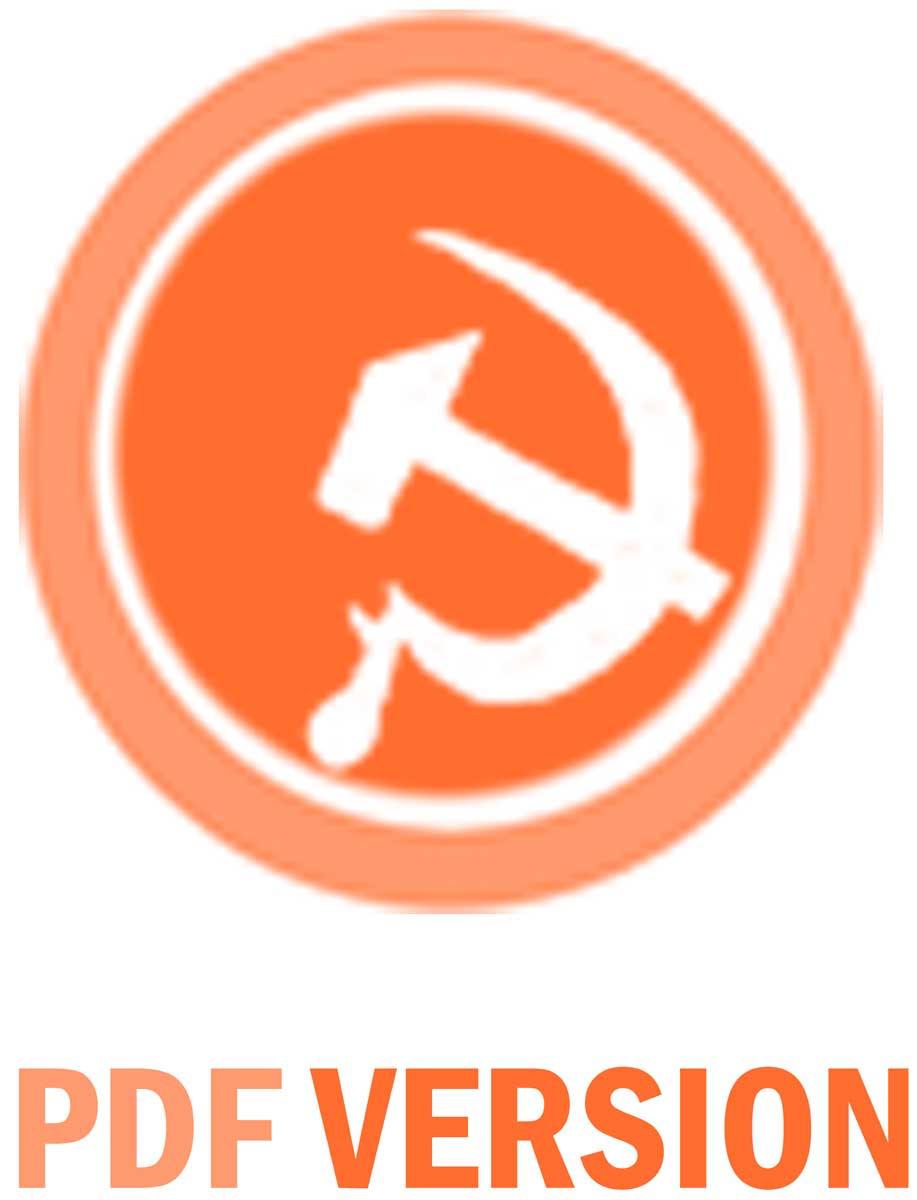
Trotskyist Platform: PO Box 1101, Fairfield NSW 1860, Australia.
E-mail: trotskyistplatform@gmail.com
Phone (Australia): 0417 204 611
Phone (International):0061 417 204 611
